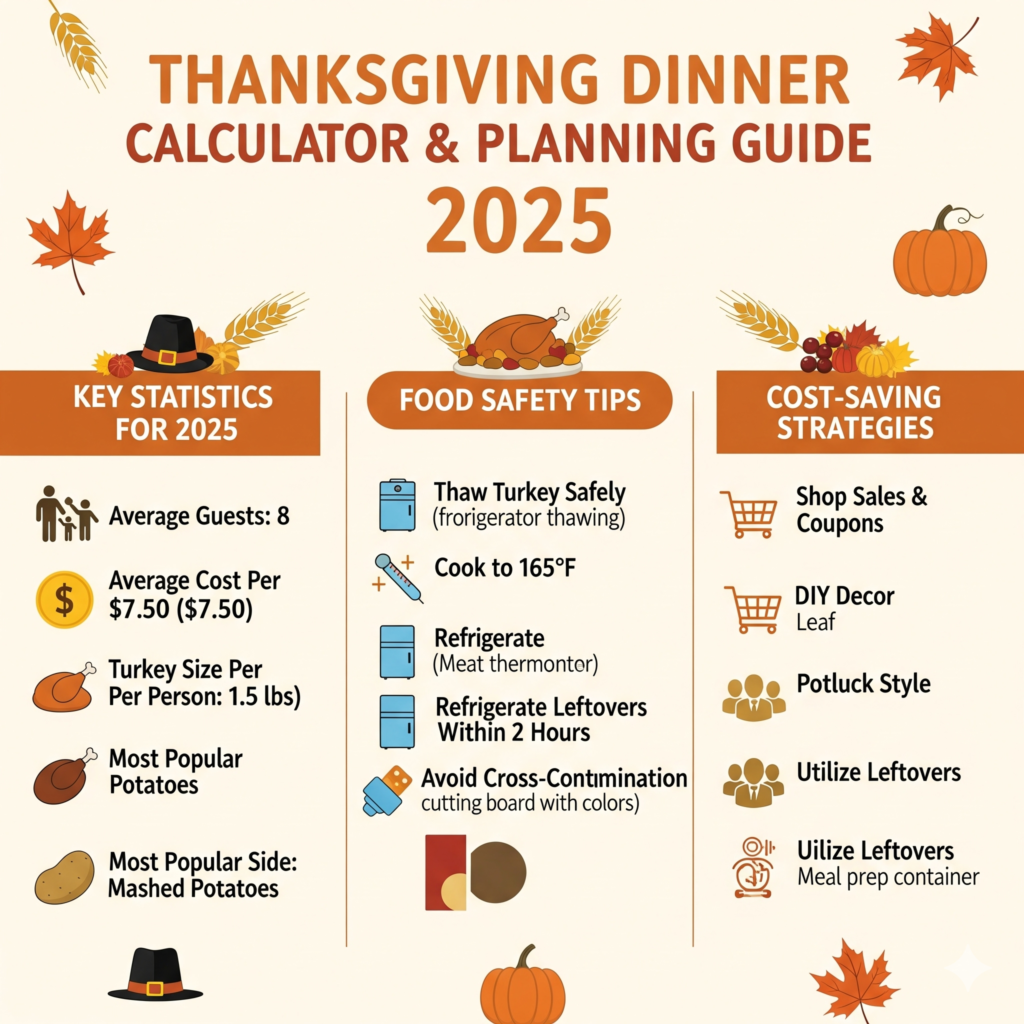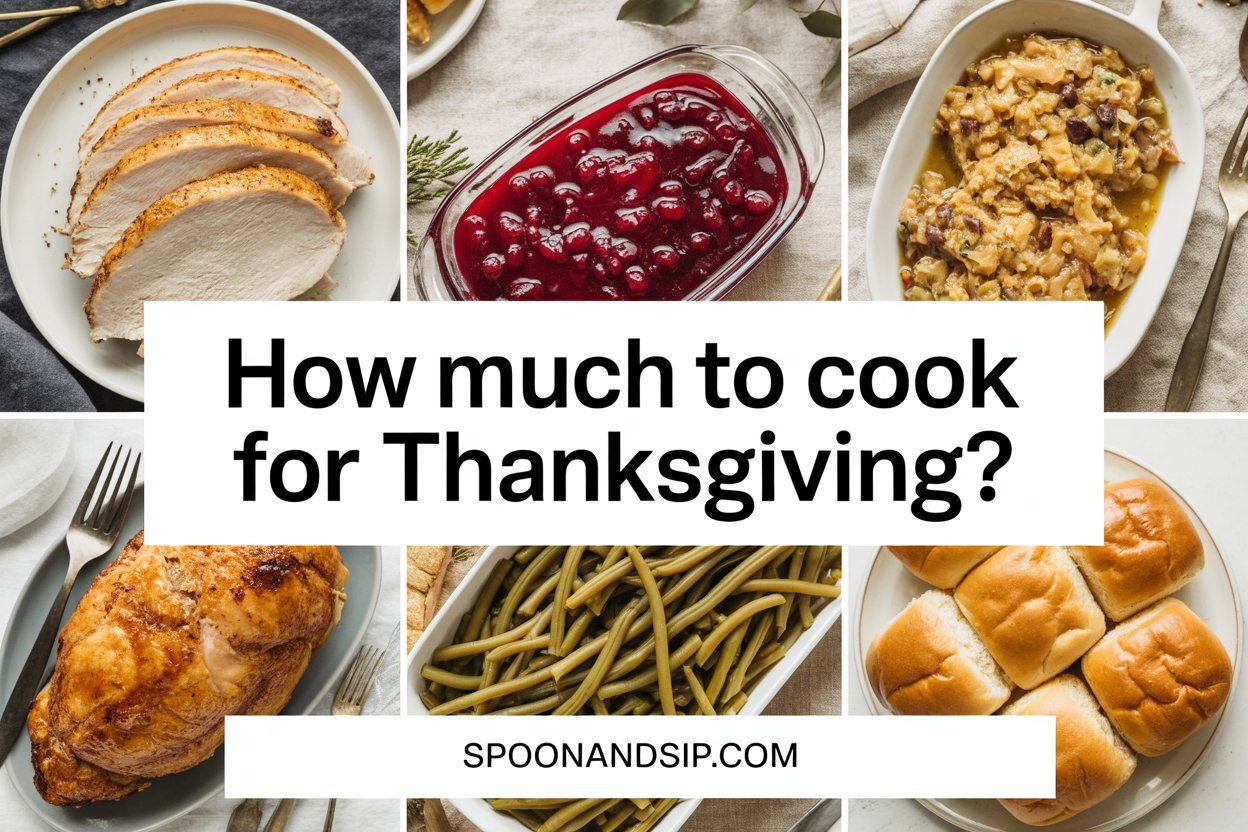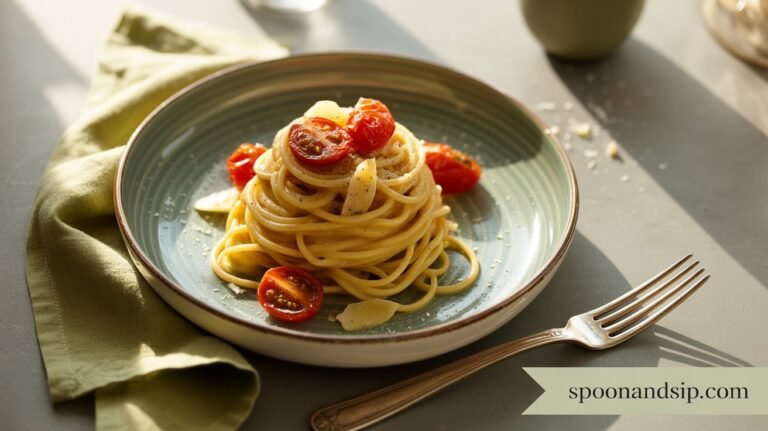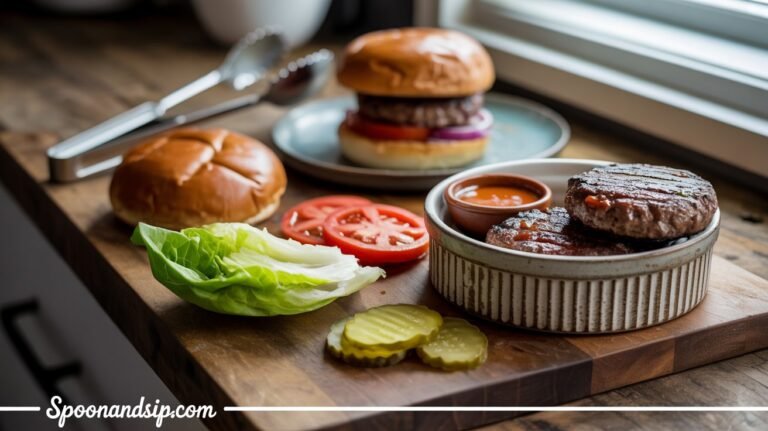🦃 Thanksgiving Dinner Calculator 2025
Plan Perfect Portions, Eliminate Food Waste & Impress Your Guests
📋 Complete Planning Guide
Bottom Line Up Front: In 2024, the average Thanksgiving meal for 10 costs $58.08, but 68% of hosts struggle with portion planning, leading to massive food waste or embarrassing shortages. This comprehensive calculator eliminates the guesswork, using expert-backed serving sizes to ensure every guest leaves satisfied while you save money and reduce waste.
Planning the perfect Thanksgiving dinner shouldn’t feel like rocket science. Yet every year, millions of hosts find themselves panic-buying last-minute groceries or watching mountains of leftovers spoil in their fridges. The stakes feel impossibly high when you’re feeding 15+ hungry relatives, and traditional advice like “buy 1 pound of turkey per person” leaves too much room for error.
This calculator changes everything. Drawing from authoritative sources like Whole Foods Market’s Holiday Servings Calculator and Food Network’s expert portion planning guidelines, it provides precise, personalized recommendations for every dish on your table. Whether you’re hosting an intimate gathering of 4 or feeding a small army of 20, you’ll know exactly what to buy—and what to skip.
Why This Calculator Is Essential for Modern Hosts
The traditional approach to Thanksgiving planning is broken. According to recent surveys, 57% of US consumers now plan to eat out for holiday meals rather than cook at home, largely because home cooking has become so stressful and wasteful. Those who do cook often rely on outdated guidelines that don’t account for modern eating habits, dietary restrictions, or the growing trend toward lighter, more health-conscious holiday meals.
The Hidden Costs of Poor Planning
Beyond the obvious financial waste, poor portion planning creates multiple problems:
- Stress and panic: Last-minute grocery runs on Thanksgiving day
- Food safety risks: Improperly stored massive leftovers
- Guest disappointment: Running out of popular dishes
- Environmental impact: Contributing to the 312 million pounds of annual Thanksgiving food waste
🔮 2025 Planning Revolution
This year, 18% of families are using portion control containers to manage intake and reduce leftovers, reflecting a growing awareness that bigger isn’t always better. Modern hosts want precision, sustainability, and peace of mind—exactly what this calculator delivers.
🧮 Interactive Thanksgiving Dinner Calculator
Perfect Portion Planner
Get expert-backed serving sizes tailored to your guest count and preferences
🎯 Your Personalized Thanksgiving Menu
💡 Pro Calculator Tips
- Kids count as 0.5 adults for most dishes (they eat smaller portions)
- Buffet style typically requires 10-15% more food than family style
- Account for dietary restrictions by adding extra vegetarian options
- Round up for items that store well (turkey, potatoes, rolls)
Foundation: The Science Behind Perfect Serving Sizes
Professional portion planning isn’t guesswork—it’s based on decades of food service research, nutritional science, and consumer behavior analysis. Understanding these fundamentals helps you make informed adjustments to the calculator recommendations.
Official USDA Guidelines
The USDA recommends 1 pound of turkey per person when accounting for bone weight, but this baseline needs adjustment based on your specific circumstances. USDA’s Food Safety and Inspection Service emphasizes that proper portioning also reduces food safety risks by minimizing the amount of perishable leftovers that need safe storage.
Industry Standards vs. Home Cooking
Restaurant and catering standards often differ from home cooking recommendations because:
- Appetite context: Restaurant guests haven’t been snacking on appetizers for hours
- Portion psychology: Home diners expect abundance and leftovers
- Serving efficiency: Professional kitchens account for precise portioning tools
✅ Calculator-Based Planning
- Eliminates guesswork and panic
- Reduces food waste by up to 40%
- Accounts for modern eating habits
- Provides clear shopping lists
- Adapts to different serving styles
❌ Traditional “Wing It” Approach
- Often results in 50%+ overbuying
- Creates massive food waste
- Ignores dietary preferences
- Causes last-minute stress
- Wastes money on unused ingredients
The Mathematics of Satisfaction
Perfect portions aren’t just about quantities—they’re about psychological satisfaction. Research shows that guests feel most satisfied when:
- Variety exceeds quantity: 6 smaller portions of different dishes beat 3 large portions
- Visual abundance: Well-arranged buffets appear more generous even with proper portions
- Seconds availability: Knowing more is available reduces the urge to overload plates initially
2025 Thanksgiving Trends & Consumer Insights
🔥 The Biggest Change: Health-Conscious Celebrations
40% of households now include low-calorie or plant-based side dishes to balance traditional items, and health awareness is driving major changes in holiday meal planning. This isn’t about deprivation—it’s about feeling good during and after the celebration.
Generational Dining Differences
The data reveals striking generational preferences that smart hosts should consider:
- Gen Z (63%): Most likely to order entire holiday meals out
- Millennials (59%): Embrace plant-based options and “Friendsgiving” celebrations
- Gen X (54%): Balance tradition with convenience solutions
- Baby Boomers (52%): Most committed to traditional home-cooked meals
The Rise of Hybrid Celebrations
Nearly 22% of diners now host or attend potluck-style Thanksgiving dinners, representing a massive shift toward shared responsibility. This trend affects portion planning because:
- Hosts need less total food but more coordination
- Variety increases without individual burden
- Dietary restrictions are easier to accommodate
- Waste decreases because everyone contributes intentionally
Technology and Planning
Modern hosts are embracing digital tools for smarter celebrations. Gen Z leads with 29% using online grocery tools and digital planning resources, compared to just 12% across all age groups. This calculator represents the next evolution in holiday planning technology.
Expert Planning Tips from Professional Chefs
Drawing insights from professional kitchens and catering services, these advanced techniques will elevate your Thanksgiving planning from amateur to expert level.
The Professional’s Timeline
Unlike home cooks who plan day-of, professionals work backwards from service time:
- 3 weeks before: Finalize guest count and menu
- 2 weeks before: Order specialty items and reserve turkey
- 1 week before: Shop for non-perishables and prep stations
- 2 days before: Final shopping and prep start
- Day before: All prep except final cooking and assembly
🎯 Chef’s Secret: The 80/20 Rule
Professional caterers plan for 80% of guests to take normal portions and 20% to want seconds of their favorite dishes. Build this into your calculations by preparing 25% extra of your three most popular dishes (usually turkey, stuffing, and potatoes) and standard amounts of everything else.
Strategic Menu Engineering
Smart hosts engineer their menus for maximum satisfaction with minimum waste:
✅ High-Impact, Low-Waste Dishes
- Mashed potatoes: Universally loved, easy portions
- Green bean casserole: Consistent portions, reheats well
- Dinner rolls: Easy to count, everyone takes one
- Cranberry sauce: Small portions, long shelf life
⚠️ High-Waste Risk Dishes
- Complex salads: Varying preferences, spoil quickly
- Specialty vegetables: Not universally popular
- Multiple stuffing varieties: Portion splitting confusion
- Elaborate appetizers: Fill guests up before dinner
Temperature and Timing Mastery
Professional kitchens succeed because they understand that Thanksgiving is a temperature management challenge. Plan your menu around these realities:
- One oven limitation: Most home cooks only have one oven, so plan accordingly
- Hold time limits: Hot food can only hold safely for 2 hours
- Reheating capacity: Factor in stovetop and microwave reheating needs
Essential Food Safety Guidelines
Proper portioning isn’t just about satisfaction—it’s about safety. Every year, foodborne illness causes 48 million illnesses, 128,000 hospitalizations, and 3,000 deaths nationwide, with holiday gatherings representing high-risk scenarios due to large quantities, extended preparation times, and temperature control challenges.
The Two-Hour Rule
All perishable foods must be refrigerated within two hours of being cooked, or one hour if the temperature is 90°F or above. This rule directly impacts portion planning because:
- Large quantities cool slowly and may exceed safe holding times
- Buffet-style service requires warming trays or frequent rotation
- Leftover management becomes crucial with large batches
🌡️ Critical Temperature Guidelines
- Turkey internal temperature: 165°F in thickest part
- Hot holding temperature: Above 140°F
- Cold storage temperature: Below 40°F
- Danger zone: 40°F to 140°F (bacteria multiply rapidly)
Smart Leftover Planning
Thanksgiving leftovers are safely stored in a refrigerator for up to four days, or can be frozen indefinitely but maintain best quality for two to six months. Plan portions with leftover safety in mind:
- Divide large dishes into smaller containers for faster cooling
- Label everything with dates and contents
- Plan leftover menus to use items within safe timeframes
- Consider guest takeaway to reduce your leftover burden
High-Risk Situations to Avoid
Certain portioning decisions create unnecessary food safety risks:
- Massive single dishes: Hard to cool safely and evenly
- Stuffed turkey: Interior may not reach safe temperatures
- Room temperature buffets: Without warming equipment, food enters danger zone
- Inadequate reheating: Leftovers must reach 165°F throughout
Cost Optimization Strategies for 2025
According to the American Farm Bureau, the average price of a Thanksgiving meal for 10 people jumped from $46.90 in 2020 to $64.05 in 2022, making cost-conscious planning more important than ever. Smart portioning is your best defense against inflation.
The Economics of Precision
Accurate portion planning saves money through multiple mechanisms:
- Eliminate overbuying: Most families overpurchase by 40-60%
- Reduce waste disposal costs: Less spoiled food means lower trash bills
- Maximize ingredient utilization: Buy exactly what you need
- Optimize storage space: Avoid renting additional refrigeration
💰 2025 Cost-Saving Trends
75% of Thanksgiving hosts now actively look for stores with the lowest food prices or purchase store-brand products. Additionally, 42% plan to use promotional coupons, representing a significant shift toward strategic shopping.
Strategic Shopping Timeline
Professional buyers follow a specific timeline to maximize savings:
- Early November: Buy non-perishables on sale and freeze turkeys
- Week before: Purchase fresh produce and dairy
- Tuesday/Wednesday: Fresh turkey and final perishables
High-Value Menu Choices
Some dishes provide exceptional value per serving, while others drain budgets quickly:
✅ Budget-Friendly High-Impact Dishes
- Mashed potatoes: $0.50 per serving, universally loved
- Stuffing from scratch: $0.75 per serving vs. $2.00 for boxed
- Homemade cranberry sauce: $0.25 per serving vs. $1.50 for canned premium
- Roasted root vegetables: $1.00 per serving, looks expensive
💸 Budget-Draining Dishes
- Premium appetizers: $3-5 per serving, fill guests up
- Exotic side dishes: $2-4 per serving, often left untouched
- Multiple protein options: Doubles costs, creates waste
- Pre-made specialty items: 300-400% markup over homemade
🎯 Cost Per Person Targets
Based on 2025 pricing data, aim for these per-person costs:
- Budget dinner: $8-12 per person
- Standard dinner: $15-20 per person
- Premium dinner: $25-35 per person
- Ultra-luxury dinner: $40+ per person
Common Planning Problems & Solutions
Even with perfect calculations, real-world Thanksgiving hosting presents unexpected challenges. Here’s how to handle the most common scenarios that derail even well-planned dinners.
The Last-Minute Guest Crisis
Problem: Your carefully calculated portions are perfect for 12, but now 15 people are coming.
Solution: Don’t panic-buy a larger turkey. Instead:
- Add one additional side dish (mashed potatoes or stuffing)
- Increase appetizers by 50% to help fill guests
- Ask late-arriving guests to bring wine or dessert
- Serve family-style to encourage sharing and moderate portions
The Picky Eater Dilemma
Problem: Your calculations assume normal consumption, but Uncle Bob only eats turkey and potatoes.
Solution: Plan for 20% of your guests to have strong preferences:
- Ensure 3-4 “universally acceptable” dishes (turkey, potatoes, rolls, one vegetable)
- Make extra of crowd-pleasers rather than adding specialty dishes
- Keep simple ingredients available for custom modifications
🚨 Emergency Additions That Always Work
- Instant mashed potatoes: Can feed 6-8 people with minimal prep
- Bagged salad: Looks intentional, stretches the meal
- Dinner rolls: Filling and everyone expects them
- Frozen vegetables: Quick cooking, universal appeal
The Dietary Restriction Surprise
Problem: You find out day-of that someone is vegetarian, diabetic, or has food allergies.
Solution: Build flexibility into your base plan:
- Always prepare at least 2 dishes that are naturally vegetarian
- Keep simple proteins available (cheese, nuts, beans)
- Offer sauces and seasonings on the side
- Have fresh fruit available as a safe dessert option
The Cooking Time Catastrophe
Problem: Everything is taking longer than expected, guests are arriving, and you’re behind schedule.
Solution: Triage your menu ruthlessly:
- Prioritize: Turkey first, then starches, then vegetables
- Simplify: Skip complex sauces and garnishes
- Delegate: Ask guests to help with final preparations
- Communicate: Keep guests informed and engaged with appetizers
Advanced Planning Techniques for Holiday Pros
Once you’ve mastered basic portion planning, these professional techniques will help you optimize every aspect of your Thanksgiving celebration.
Menu Engineering Psychology
Professional caterers understand that guest satisfaction depends as much on psychology as quantity. Apply these principles:
- Visual abundance: Wide, shallow serving dishes look more generous than deep ones
- Color variety: Guests eat more when they see diverse colors
- Strategic placement: Put expensive items at the end of buffet lines
- Portion control tools: Smaller serving spoons naturally control portions
🧠 The Paradox of Choice
Research shows that 7-9 total dishes (including dessert) create optimal satisfaction. More choices actually decrease enjoyment as guests become overwhelmed and worry about missing something better.
Advanced Temperature Management
Professional kitchens manage multiple temperature zones simultaneously. Recreate this at home:
- Hot zone: Oven + slow cooker for proteins and hot sides
- Warm zone: Warming drawer or low oven for holding
- Cold zone: Refrigerator + coolers for salads and desserts
- Room temperature zone: Bread, condiments, beverages
Scaling Calculations for Large Groups
When feeding 20+ people, linear scaling doesn’t work. Use these professional adjustments:
- Appetizers: Reduce per-person portions by 15% (social eating fills gaps)
- Proteins: Reduce per-person portions by 10% (variety compensates)
- Starches: Keep full portions (universal appeal, filling)
- Vegetables: Increase variety but reduce individual portions by 20%
🏆 Professional’s Secret: The Reserve System
Always prepare 20% extra of your two most popular dishes, but keep them in reserve. Only bring them out if needed. This prevents overservice while ensuring you never run out of crowd favorites.
Leftover Value Engineering
Plan your portions with leftover meals in mind. Strategic overproduction of certain items creates intentional leftovers that transform into different meals:
- Extra turkey: Sandwiches, soup, pot pie
- Extra mashed potatoes: Shepherd’s pie topping, potato pancakes
- Extra cranberry sauce: Salad dressing base, dessert topping
- Extra rolls: Stuffing base, bread pudding
Your Perfect Thanksgiving Starts Here
The Bottom Line: Perfect Thanksgiving hosting isn’t about cooking everything from scratch or impressing guests with exotic dishes. It’s about careful planning, precise portioning, and creating an atmosphere where everyone feels welcomed and well-fed without waste or stress.
This calculator eliminates the guesswork that has plagued holiday cooks for generations. By combining professional food service standards with modern consumer behavior data, it provides the precision you need to host confidently. With 18% of families now embracing portion control containers and strategic planning, you’re joining a movement toward smarter, more sustainable celebrations.
🎯 Your Next Steps
- Use the calculator to determine your exact quantities
- Create your shopping list 2 weeks before Thanksgiving
- Plan your prep schedule working backwards from serving time
- Set up your serving stations with proper temperature control
- Enjoy your stress-free, perfectly portioned Thanksgiving dinner
Remember that Thanksgiving is about gratitude and connection, not perfection. This calculator gives you the confidence to focus on what truly matters: spending quality time with the people you care about most. When your portions are planned and your timing is solid, you’re free to be present for the conversations, laughter, and memories that make the holiday special.
Share this calculator with fellow hosts, save it for future years, and make it part of your annual planning routine. Here’s to a Thanksgiving that’s perfectly planned, beautifully executed, and genuinely enjoyed by everyone—including you.

 Skip to content
Skip to content



